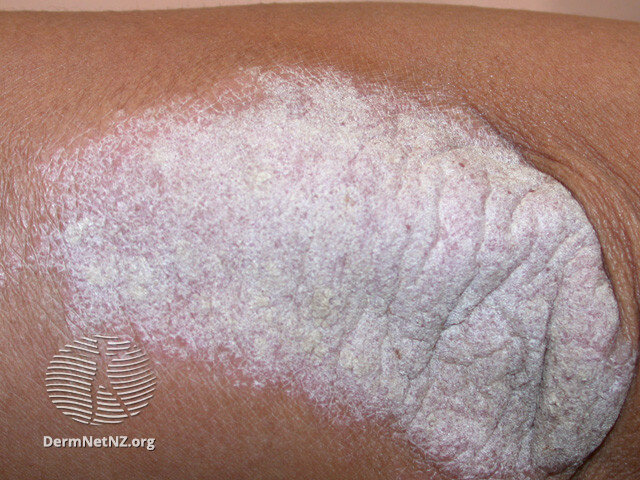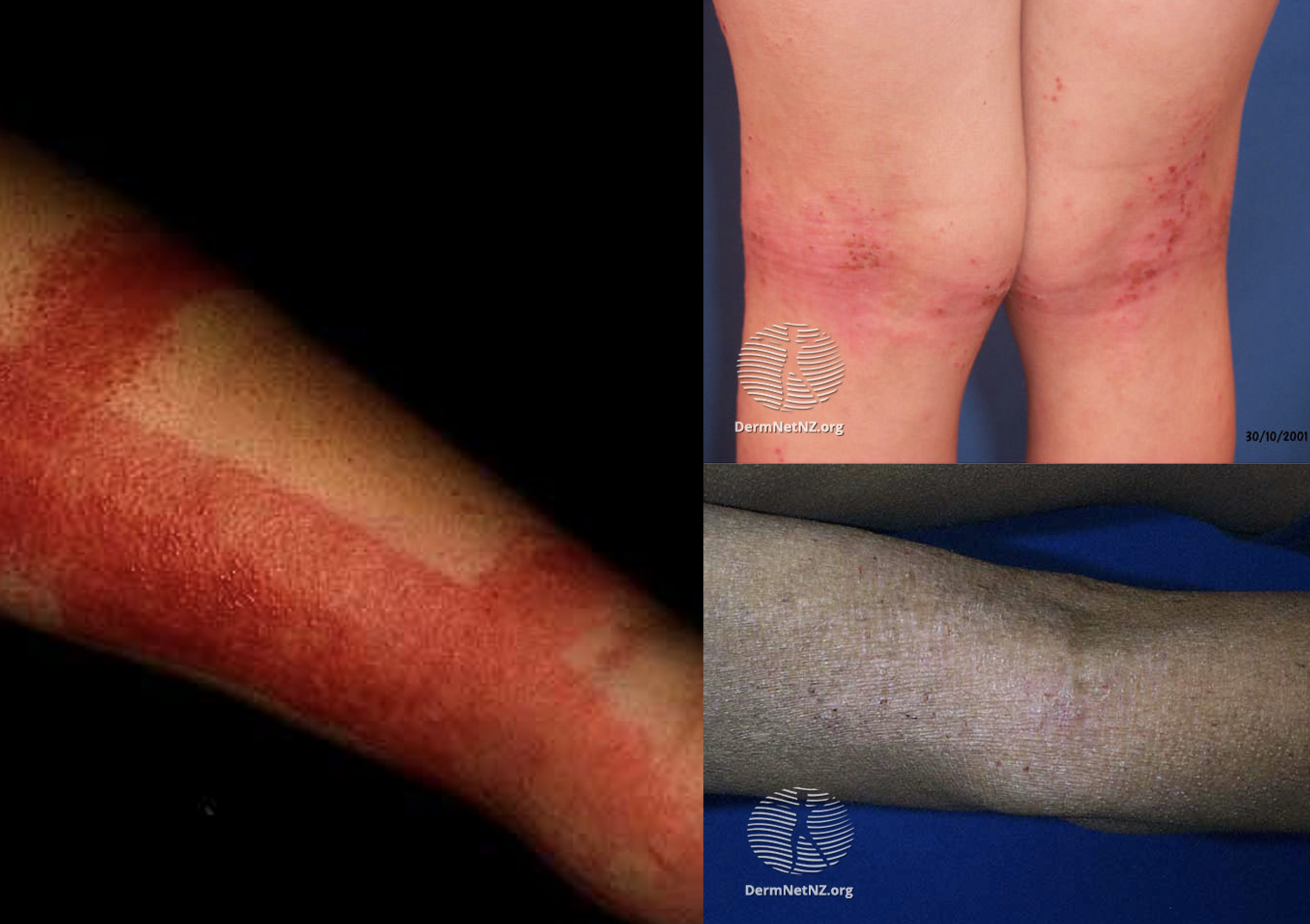The Lifelong and Persistent Skin Condition — Psoriasis.
Psoriasis
Psoriasis is a common, chronic and non-infectious skin disorder. Psoriasis can be classified into several subtypes as there are variable presentations.
Key aspects
It is a lifelong condition that fluctuates in severity. It is generally seen as a well-defined red and scaly plaque (a plaque is a palpable flat top raised lesion that is generally bigger than 0.5 cm in diameter). Psoriasis may be mild and can be slightly noticed, or can be severe.
Its prevalence is about 2-4% in the population, but it is believed to be underestimated. Psoriasis may occur for the first time during childhood; however, it is uncommon for children under the age of 8. Psoriasis presents itself as a bimodal distribution and may peak between 15-25 (known as early-onset psoriasis or type I) and 50-60 (late-onset psoriasis, also termed type II psoriasis). Both types cannot be distinguished through its clinical presentation or histopathologically; hence, they overlap giving the bimodal-like distribution. Caucasian patients are mostly affected, but other patients of darker skin tone may have undiagnosed psoriasis decreasing its prevalence in people of colour. 1 in 3 patients with psoriasis has sporadic arthritis, which is commonly seen in peripheral polyarthropathy (a term used when at least five joints are affected with arthritis) and peripheral enthesopathy (the place where a tendon or ligament meets your bone is called an enthesis, thus enthesopathy is an umbrella term for conditions that affect these connection points).
Etiological factors
Psoriasis is a multifactorial condition, and its main classification is an immune-mediated inflammatory disease (IMID). Psoriasis is associated with an immune dysregulation where T-cells function have been found to behave abnormally, and it is clear that inflammatory cytokines are responsible for the clinical features. Genetics is a key factor and dictates its severity and the patient's ability to treat the psoriatic lesion successfully. It is noticed in psoriasis that there is an increase in epidermal turnover, where the epidermis renews itself too quickly, causing an immature and abnormal surface. Still, there is a need to explain why the skin is red, thickened and inflamed. The current theories are pointing towards the TH17 pathway and its cytokine release. The experts and specialist have been focusing a lot on the immune system as well as genetics. We can safely say that psoriasis is intricate and complicated.
Aggravating factors
Family history and genetics. Patients may present with genes that correlates to the severity of their psoriasis.
Cold and dry weather.
Streptococcal infections often induce psoriasis especially for psoriasis guttae.
Trauma may induce psoriasis on the flexor surface; this is known as the koebner phenomenon.
Medications: beta-blockers, NSAIDs, hydroxychloroquine, lithium and withdrawing steroid such as prednisone.
Excess smoking and/or alcohol consumption.
Metabolic syndrome.
Sun exposure, although the sun is found to be beneficial and a type of treatment.
Stress.
Clinical features
As mention, psoriasis is seen as a well-defined red and scaly plaque. The scales have a white/silver appearance except there are no scales when the lesion appears in the folds such as the genital and under the breast area. It is commonly distributed symmetrically on the body and is seen on the scalp, elbows, knees and lower back. It is worthy of mentioning that psoriasis is more prominent on the extensor surfaces of the body.
Depending on the severity, the plaques can be persistent and resistant to treatment. Itching may be severe, which leads to lichenification (which describes the increased skin thickening and markings) from over scratching the lesion. Psoriasis is unusual on the face of an adult but can be commonly found on the face of children. Nail abnormalities are common in psoriasis where pitting, ridging and onycholysis may occur. Auspitz sign should be positive (where small bleeds occur after peeling a plaque off).
Figure 1: Demonstrates plaque psoriasis clinical features, its distribution on the body, associated disorders and types of treatment.
Image from: Armstrong AW. Psoriasis. JAMA Dermatol. 2017;153(9):956. doi: 10.1001/jamadermatol.2017.2103
Different variants of psoriasis
Chronic plaque psoriasis (most common at 90% of the time)
Scalp psoriasis
Guttate psoriasis
Palmoplantar psoriasis
Nail psoriasis
Genital psoriasis
Flexural psoriasis
Pustular psoriasis
Erythroderma psoriasis
Children with psoriasis
Differentials and complications
Differentials
Other diseases to look for that may resemble psoriasis are:
Tinea (fungal infection): usually asymmetrical, found in humid weather, central clearance, use skin scrapping to differentiate.
Folliculitis: look fr hair follicles that are inflamed, may also be an infection.
Discoid dermatitis: coin shape, very itchy, found on trunk and limbs.
Seborrhoeic dermatitis: no plaques, poorly defined outline.
Skin cancer: telangiectasia, rolled pearly edge, change in colour or diameter, sun-related, asymmetrical, nails are usually not affected.
Pityriasis rosea: similar to guttate psoriasis but precedes infections that occurred 6-12 weeks ago, herald patch may be seen.
Intertrigo: look similar to flexural psoriasis and is challenging to differentiate, usually has a poorly defined border.
Complications
Psoriatic arthropathy.
Increase in mental illness or low self-esteem due to psychological and social factors.
Lichenification.
Infection of the skin.
People with psoriasis are more likely to develop metabolic syndromes such as obesity, type 2 diabetes, high blood pressure, gout and cardiovascular diseases.
Other autoimmune conditions as psoriasis are linked to a dysregulated immune response.
Inflammatory conditions, such as Crohn’s disease.
Psychological distress.
Treatment
As seen in the differentials, being sure of the diagnosis is crucial in treating psoriasis, thus look at its clinical features or have a healthcare professional perform a skin biopsy for certainty. It is essential to explain to the patient that psoriasis is a lifelong/chronic disease and takes time and patience to treat. Referral to a specialist may be necessary. An important aspect of treatment is to identify and tackle any contributing factors (see above).
Treating psoriasis include:
Avoid aggravating factors and lifestyle modification.
Use of emollients.
Use of topical anti-inflammatory or corticosteroids.
Coal tar preparation.
Vitamin D analogues.
Phototherapy.
Systemic approach, such as methotrexate.
Use of biologics, such as monoclonal antibodies (mAb).
Psychological treatment and social support.
The severity will dictate what type of treatment should be used and type of medication combinations.
Published 10th December 2020. Last reviewed 1st December 2021.
Reference
Alpay-Kanıtez N, Çelik S, Bes C. Polyarthritis and its differential diagnosis. Eur J Rheumatol. 2018;6(4):167-173. doi: 10.5152/eurjrheum.2019.19145
Armstrong AW. Psoriasis. JAMA Dermatol. 2017;153(9):956. doi: 10.1001/jamadermatol.2017.2103
David Zelman, MD. Enthesopathy and Enthesitis. WebMD website. Reviewed April 30, 2019. Accessed November 30, 2020.
Hon A/Prof Amanda Oakley, Dermatologist, Hamilton, New Zealand, 1997. Psoriasis. Dermnet NZ website. https://dermnetnz.org/topics/psoriasis/. Updated August, 2014. Accessed November 30, 2020.
Mayoclinic authors. Psoriasis. Mayoclinic website. https://www.mayoclinic.org/diseases-conditions/psoriasis/symptoms-causes/syc-20355840. Updated May 2, 2020. Accessed December 3, 2020.
Queiro R, Tejón P, Alonso S, Coto P. Age at disease onset: a key factor for understanding psoriatic disease. Rheumatology. 2014;53(7):1178-1185. https://doi.org/10.1093/rheumatology/ket363
Stephanie S. Gardner, MD. Is Psoriasis an Autoimmune Disease? WebMD website. https://www.webmd.com/skin-problems-and-treatments/psoriasis/psoriasis-autoimmune. Reviewed September 28, 2019. Accessed December 3, 2020.




























